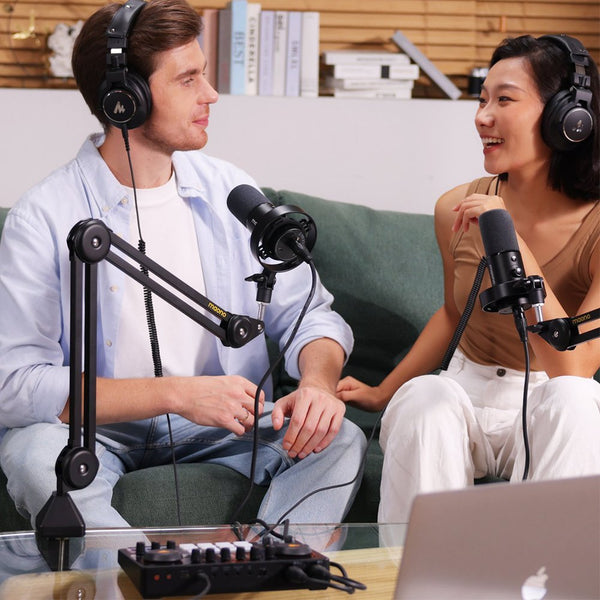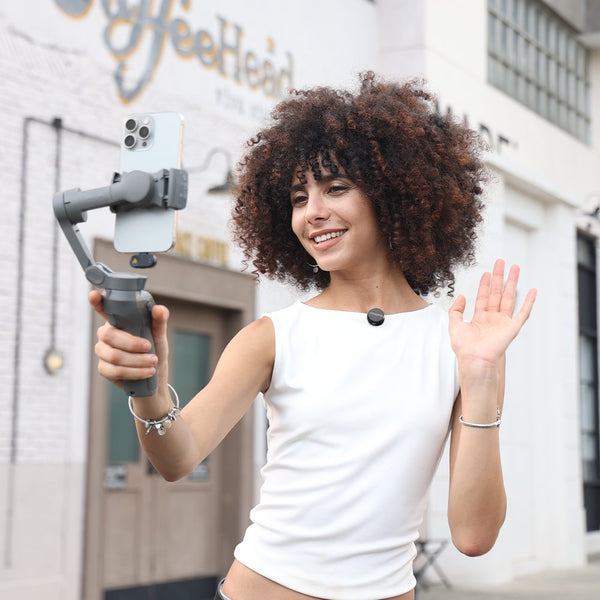It might seem obvious, but it’s a question worth asking: Why bother investing in a good podcast microphone at all? Choosing the best mic for podcasting is essential because it helps capture high-quality audio, which is crucial for engaging and retaining listeners. It also minimizes background noise and other distractions that can detract from the overall listening experience — an important part of a great podcast microphone setup for beginners.
In this article, we’ll explore the similarities and differences between USB vs XLR microphones for podcasting, as well as the distinctions between dynamic and condenser microphones, and omnidirectional and cardioid microphones. You’ll also learn helpful tips for choosing the right USB microphone for podcasting—especially for beginners—and get recommendations to help you find the top mic for podcasting that fits your setup and goals.
Should I Choose an XLR or USB Microphone for Podcast?
XLR and USB simply refer to the type of cable a microphone uses.
A USB microphone is a plug-and-play device that works directly with computers and USB-compatible devices, perfect for those looking for an affordable mic for podcasting beginners. An XLR microphone, on the other hand, is designed for use with audio interfaces and mixers — a better fit if you plan to build a professional podcast recording equipment setup over time.
Choosing between USB vs XLR microphones for podcasting depends on your recording needs and future goals. USB models are simple, while XLR mics provide flexibility for scaling into professional production.
Read this article for more information: Basic Audio Terms You Should Learn Before Buying a Microphone
USB Microphones:
- Ease of Use: They’re plug-and-play, making them ideal for beginners.
- Portability: Great for on-the-go recording since they don’t require additional equipment.
- Cost-Effective: Generally less expensive, making them accessible for those starting out.
Advantages of Using USB Microphones for Podcasting:
1. Ease of Use: USB microphones are typically easy to set up, requiring minimal technical knowledge. Just plug it in, and you’re ready to record.
2. Cost-Effective: Many affordable podcast microphones 2025 are USB-based, perfect for budget-conscious creators.
3. Portability: USB microphones are usually lightweight and compact, making them convenient for on-the-go recording or remote podcasting.
4. Direct Digital Recording: The USB connection allows for direct digital recording, reducing noise interference and improving sound quality.
5. Built-In Features: Many USB microphones come with built-in features like gain control and headphone outputs, providing users with greater control over their audio.
6. Compatibility: They work seamlessly with most recording software and digital audio workstations, making them versatile for various recording setups.7. Noise Control: Many include basic noise rejection, making them similar to a podcasting mic with noise cancellation.
These advantages make USB microphones an excellent choice for podcasters looking to achieve high-quality audio without complex equipment.
Quick Tips for using Your USB Microphone as a Podcasting Mic Effectively:
Here are some specific tips for using USB microphones effectively in a podcasting setup:
1. Choose the Right Location:
- Quiet Environment: Set up in a quiet room to minimize background noise. Soft furnishings can help absorb sound reflections.
- Microphone Placement: Position the microphone about 6-12 inches away from your mouth for optimal sound capture. Use a pop filter to reduce plosive sounds.
2. Adjust Settings:
- Gain Control: Adjust the microphone gain to avoid distortion. Start low and increase until you find the right level without clipping.
- Monitor Audio Levels: Use headphones to monitor your audio in real-time. This helps catch any issues before they become a problem.
3. Utilize Software Features:
- Recording Software: Use quality recording software (like Audacity or GarageBand) that allows you to adjust audio levels and apply effects.
- Track Separation: If possible, record each speaker on a separate track for easier editing.
4. Maintain Consistency:
- Stay in One Position: Keep a consistent distance and angle from the microphone throughout the recording to maintain audio quality.
- Use a Shock Mount: Consider using a shock mount to reduce vibrations and handling noise.
5. Plan Your Content:
- Outline Your Episodes: Prepare an outline or script to stay focused and organized during recordings.
- Practice Speaking: Work on your pacing and clarity. Practice speaking into the microphone to find your best voice and tone.
6. Post-Production Editing:
- Edit for Clarity: Use audio editing software to remove any mistakes, pauses, or background noise.
- Add Music and Effects: Enhance your podcast with music or sound effects, ensuring they are at an appropriate volume relative to your voice.
7. Test Before Recording:
- Conduct Test Runs: Always do a short test recording before the actual session to check the audio quality and levels.
- Evaluate Sound Quality: Listen to the test recording to make any necessary adjustments.
Tip: To get professional results even at home, your podcast microphone setup for beginners should focus on placement, gain control, and consistency. Position the mic 6–12 inches from your mouth, use a pop filter, and monitor your audio with headphones. Test your levels before recording and edit your audio for clarity.
Following these tips can help you maximize the effectiveness of your USB microphone and produce high-quality audio for your podcast.
This time, let's find out the advantage of choosing XLR microphones for podcasting.
XLR Microphones for Professional Podcasting
If you’re building a more advanced setup, an XLR microphone connected to an interface or mixer provides studio-grade audio control. Pair it with professional podcast recording equipment such as a boom arm, interface, and closed-back headphones. These are excellent if you’re planning to invest in a professional podcasting mic under $200 that delivers lasting performance.
- Sound Quality: Often provide superior audio quality, especially in professional settings.
- Flexibility: Can be used with audio interfaces and mixers, allowing for more control over sound.
- Scalability: Better for long-term podcasting plans as you can upgrade your setup as needed.
Are USB microphones good for professional podcasting?
If you're a beginner in podcasting, a USB microphone is usually sufficient and user-friendly. But if you're an advanced podcaster, an XLR microphone is a better investment if you're looking for high quality audio, customize your sound effects, and plan to grow your setup. So, the answer ultimately depends on your specific requirements and future podcasting goals.
Maono offers a collection of the best USB and XLR microphones, ranging from entry-level to advanced options. Check it out now for a reasonable price: Maono.com.
Dynamic vs. Condenser Podcast Mics
The terms “condenser” and “dynamic” refer to two different ways microphones are built and function.
Dynamic microphones are best for untreated or noisy rooms, while condenser mics capture richer vocal detail in quiet spaces — a crucial factor when choosing the best mic for podcasting at home.
The dynamic mics use a diaphragm, voice coil and magnet to pick the sound waves and convert them into an electrical signal. Condenser microphone use an electrically-charged diaphragm, which when vibrates, an electrical signal is generated that is proportional to the sound.
Omnidirectional Microphone and Cardioid Microphone Podcast USB
“Omnidirectional” and “cardioid” refer to one aspect of a mic’s specification, known as its polar or pick up pattern.
What are omnidirectional microphones? Omnidirectional microphones are microphones that pick up sound with equal gain from all sides or directions of the microphone. On the other hand, a cardioid microphone has a unidirectional cardioid polar/pickup pattern. It is most sensitive to on-axis sounds (where the mic “points”).
Omnidirectional vs. Cardioid Polar Pattern
Hopefully, the following diagrams will help you visualize how omnidirectional and cardioid polar patterns compare:

The most common mic pattern In studio, stage, and broadcasting, is the cardioid polar pattern.
The XLR/USB dual mode internet dynamic podcasting microphone PD400X is our top recommended microphones that we believe will deliver the best sound quality for your podcast.

Here is the result of PD400X sound effect test compared with the other brand.

Let's check more details of what others think of the differences between PD400X and Shure MV7
Meanwhile the PD400X dynamic microphone, which combines the dual benefits of USB and XLR recording and allows them to be used simultaneously when needed. Maono makes the best podcasting mic you can use right now. The PD400X is a cardioid condenser microphone that delivers incredible audio.
Features include:
- Combination of a dynamic capsule and cardioid podcast microphone more perfect for recording.
- 3-in-1 multi-functional composite knob easily rotate to adjust microphone gain, headphone volume, and monitor ratio; press the knob to switch.
- One-key mute.
- USB or XLR output, use a wider range of equipment.
- Standard 3/8" and 5/8" thread interface you can connect any bracket you like.
- The MAONO LINK app provides more functions.
- Usage collection: suitable for studio recording, home recording, podcasting, and live broadcasting.
- 12-month warranty; if you don’t like it, return it anytime within 30 days. lifetime technical service support.
- All in the box: Podcast Microphone, XLR Cable, USB-C to USB-A/C Cable, Metal Base, Windscreen.
User Reviews/Testimonials:
- The famous influencer, C Paws Music prefer a dynamic USB&XLR microphone like the PD400X. According to him: "The microphone itself is made of metal and feels super premium, I've been using this microphone for my stream and YouTube videos, and I personal like it, actually."
- Lo Knows Tech with 27.2K followers in YouTube favors the AME2 audio interface: "The MaonoCaster E2 (AME2) really gives it a look, especially if you are really trying to get into podcasting, looking for a device that'll power a condenser mic, that does give you the phantom power, you have to definitely take a look at this audio mixer."
Tips for Selecting the Right Podcasting Mic for Beginners
Choosing the right USB microphone for podcasting can significantly impact your audio quality and overall experience. Here’s a quick guide to help you make the best choice as a beginner.
1. Understand Your Needs
Before diving into specifications, consider what you need the microphone for. Are you recording solo podcasts, interviews, or group discussions? This will guide your choice in features and design.
2. Choose the Right Pickup Pattern
Microphones have different pickup patterns that determine how they capture sound. For podcasting:
- Cardioid: Best for solo recordings and interviews, as it picks up sound from the front while reducing background noise.
- Omnidirectional: Suitable for roundtable discussions since it captures sound from all directions.
3. Check the Sound Quality
Look for microphones with good reviews regarding sound clarity and quality. Even as a beginner, aim for a model that captures clear audio without distortion. Brands like Maono often provide excellent sound quality at affordable prices.
4. Consider Build Quality and Design
A sturdy microphone will last longer. Look for features like a shock mount to minimize vibrations and a pop filter to reduce plosive sounds. A microphone with a stand or adjustable height can also improve comfort during recording.
5. Ease of Use
Select a plug-and-play USB microphone that doesn’t require extensive setup. The simpler, the better, especially if you’re just starting. Ensure it’s compatible with your computer’s operating system.
6. Budget Wisely
USB microphones come in various price ranges. As a beginner, you don’t need the most expensive option, but investing in a reliable microphone is essential. Aim for a balance between quality and cost—many mid-range options offer excellent value.
7. Read Reviews and Watch Tutorials
Before making a purchase, read user reviews and watch tutorial videos. They can provide insights into real-world performance and ease of use, helping you feel more confident in your choice.
8. Don’t Forget Accessories
Consider additional accessories like a pop filter, shock mount, or a sturdy stand. These can enhance your recording experience and improve sound quality.
Keeping these tips in mind will help you on your way to selecting the right USB microphone for your podcasting journey. Remember, the right equipment can elevate your content, making your podcast more enjoyable for both you and your listeners. Happy podcasting!
TOP PICKS FOR 2025
Podcast Equipment Bundle Recommendation
Check out this podcast equipment bundle with USB/XLR PD400X microphone and BA37 boom arm:
Podcast Microphone Kit 1: PD400X +BA37 | Price at About $159.99 | Shop Now
Podcast microphone Kit 2: PD400X +AME2 | Price at About $259.99 | Shop Now

Specifications | AME2 Audio Interface
|
Compatible Devices |
Computer, Tablet, Camera, Smartphone |
|
Supported Software |
OBS/Discord/Zoom/Audacity/YouTube/Facebook/TikTok/Twitch |
|
Connectivity Technology |
XLR, 3.5MMTRRS,6.35MM,USB type C |
|
Number of Channels |
10 |
|
Frequency Response |
20000 Hz |
|
Operating System |
MAC OS, Windows |
|
Audio Input |
Bluetooth, 1/4 Audio, 3.5mm Audio/XLR |
|
Maximum Sample Rate |
48000 Hz |
Podcast Microphone Kit 3: PD400X +MH601
Specifications | MH601 Gaming Headphones
|
Model Name |
AU-MH601 Studio monitor headphones |
|
Color |
MH601 Studio Headphones |
|
Form Factor |
Over Ear closeback design |
|
Connectivity Technology |
3.5mm cable, 6.5mm adapter |
|
Wireless Communication Technology |
3.5MM cable connect |
|
Special Feature |
Detachable Cable/Adjustable Headband/Foldable/Surround Sound/music share interface |
|
Included Components |
Studio monitor headphones, Detachable coil cable, User manual |
|
Age Range (Description) |
Adult |
|
Material |
Plastic |
Besides the PD400X dynamic microphone, you might be wondering if there are other options from Maono for podcasting. You might be interested in reading our article on "How to Choose the Perfect Maono Podcasting Microphone," where we have a list of microphones at different price ranges to help users make better selections.
There are many podcast microphone brands on the market, and sometimes you might feel confused about which microphone to select and have no idea how to choose a suitable one. In fact, you can ask yourself a few questions first, and that will help you know which one to buy.
1. How Much Budget Do I Have? What kind of equipment do I want to connect to and which kind of plug does the microphone need to have, USB or XLR or both of them? Do I need to buy other accessories such as earphones, sound cards, etc. for functional upgrades in the future?
2. What are the scenarios the microphone is used for? Is it for content creation, video recording, live podcasting, etc.? Then you will know if you need to to select the omnidirectional mic or cardioid mic.
3. Have a better understanding of the difference between dynamic microphones and condenser microphones according to your needs.
4. The final important search is the microphone brand, as the best-selling microphone brand on the market, you will know which microphone you need to pick up.
How to Choose the Best Mic for Podcasting
Choosing the best mic for podcasting depends on your recording style, environment, and budget. A great microphone should deliver clear, natural sound while minimizing background noise. Beginners should consider ease of use, connectivity options (USB or XLR), and microphone type (dynamic or condenser). Think about where you’ll be recording — at home, in a studio, or on the go — and how many hosts or guests you’ll have. The right mic will balance quality, convenience, and affordability for your podcast setup.
Podcast Mic Selection Checklist
1. Podcast Format
-
Solo podcast → Look for a cardioid mic for focused voice capture.
-
Interview or co-hosted podcast → Choose multiple mics or one with dual pickup patterns.
-
Roundtable or group recording → Consider omnidirectional or multi-pattern mics.
2. Budget
-
Entry-level: Look for the best cheap wireless mic or budget-friendly USB options.
-
Mid-range: Consider budget wireless microphones or XLR mics with an audio interface.
-
Professional: Invest in high-end condenser or dynamic XLR microphones for studio setups.
3. Mic Type
-
Dynamic Mic – Great for untreated rooms; resists background noise.
-
Condenser Mic – Ideal for controlled environments; captures rich vocal detail.
4. Connectivity
-
USB Microphone – Plug-and-play for beginners and solo podcasters.
-
XLR Microphone – Offers professional-grade audio and upgrade flexibility.
5. Recording Environment
-
Quiet home setup → Condenser or USB mic.
-
Noisy or live environment → Dynamic or directional mic.
6. Extra Features
-
Built-in gain control, mute button, and headphone monitoring for real-time feedback.
Top Picks for the Best Mic for Podcasting in 2025
When selecting the best mic for podcasting in 2025, you’ll want to balance budget, connectivity (USB vs XLR), build quality, and features that truly impact voice clarity and workflow. Below are four strong contenders — covering affordable entry-level options up to more advanced studio choices — each chosen because they deliver value, flexibility, and sound quality suited for podcasters of different levels.
Recommended Microphones Comparison
|
Microphone |
Approx. Price Range |
Pros |
Cons |
Why It’s a Top Pick |
|
Maono PD400X |
~$149.99–$199 |
Dual USB/XLR connectivity, onboard EQ, premium build |
Slightly pricier for beginners |
Great professional podcasting mic under $200 for studio-quality sound |
|
~$79–$129 |
RGB lighting, USB/XLR dual-mode, great vocal clarity |
No built-in mute button |
Perfect mid-tier top mic for podcasting with creative flair |
|
|
~$59.99–$69 |
Plug-and-play USB setup, complete kit included |
Limited sound customization |
Ideal affordable mic for podcasting beginners |
|
|
~$69.99–$99 |
Clear condenser sound, easy gain control, durable arm stand |
Sensitive to background noise |
Excellent choice for best mic for podcasting at home setups |
Summary & Recommendation
-
For beginners on a tight budget, the Maono A04/AU-A04 offers great value and all the basics you need to get started.
-
If you want a budget upgrade with dual connectivity and better noise rejection, the PD200X is a smart jump.
-
For intermediate-to-advanced setups, the PM422 offers strong features in USB-only form, making it easy yet powerful.
-
For professional mindset or future-proof setups, the PD400X is excellent — allowing for USB now and XLR later, suitable for growth, guest setups, or more treated rooms.
Aim to pick the mic that best aligns with your current setup, environment (room acoustics matter), and growth plans. With any of these, you’ll be well on your way to owning one of the best mic for podcasting in 2025.
✅ Tip: If you’re new to podcasting, start with the A04 or PM422 for simplicity. For advanced recording flexibility, upgrade to the PD200X or PD400X, which offer dual-mode (USB/XLR) compatibility and richer tone control.
FAQs:
1. What features should I look for in a USB microphone for podcasting?
The Maono USB microphones are ideal for podcasting due to several key features:
- Plug-and-Play Functionality: Easily connects to computers without the need for additional equipment or drivers.
- Cardioid Pickup Pattern: Focuses on sound from the front, reducing background noise and enhancing vocal clarity.
- Adjustable Gain Control: Allows users to modify input sensitivity, ensuring optimal recording levels.
- Built-in Headphone Jack: Enables real-time monitoring, so podcasters can hear their audio without latency.
- Durable Build Quality: Designed to withstand regular use while maintaining performance.
- Affordable Price: Provides excellent quality at a budget-friendly price, making it accessible for beginners and professionals alike.
2. How does the sound quality of Maono USB microphones compare to XLR options?
While XLR microphones are often considered the standard for professional audio due to their higher sound quality and versatility, Maono USB microphones still deliver impressive audio performance. Key comparisons include:
- Clarity: Maono USB microphones provide clear and detailed sound suitable for podcasting, although high-end XLR microphones may offer superior clarity in demanding environments.
- Noise Handling: The cardioid pattern of Maono microphones effectively reduces ambient noise, making them suitable for home studio setups.
- Convenience: USB microphones are easier to set up and use, making them a great choice for those who prioritize convenience over the highest audio fidelity. Overall, while XLR microphones may edge out in professional contexts, Maono USB microphones offer excellent quality for most podcasting needs.
3. How do you set up the Maono USB microphone for optimal recording?
Setting up the Maono USB microphone for optimal recording involves the following steps:
1. Connect the Microphone: Plug the USB cable into the microphone and connect it to a USB port on your computer.
2. Select the Microphone in Settings: Go to your computer's audio settings and select the Maono USB microphone as the input device.
3. Adjust Gain Levels: Use the gain control knob on the microphone to set the input sensitivity. Speak into the microphone at your usual volume and adjust the gain until your audio peaks at around -12dB to -6dB on your recording software.
4. Use a Pop Filter: If possible, place a pop filter in front of the microphone to reduce plosive sounds (like "p" and "b" sounds).
5. Positioning: Position the microphone about 6-12 inches away from your mouth, angled slightly towards you for optimal sound capture.
6. Monitor Your Audio: Plug headphones into the microphone’s headphone jack to monitor your audio in real-time and make adjustments as necessary.
7. Test and Record: Conduct a test recording to check for sound quality and background noise. Make any final adjustments to positioning or gain before starting your actual podcast.
4. What is the best mic for podcasting for beginners?
For beginners, the best mic for podcasting is a USB-plug-and-play microphone with a cardioid (voice-focused) pickup pattern, because it’s easy to use, requires minimal setup, and offers good voice clarity without needing additional gear.
5. Which mic should I choose if I do interviews/panel shows?
If you do interviews or panel shows (multiple voices or guests), you should choose a microphone (or multiple microphones) with a cardioid or multi-pattern capability and connectivity that supports multiple inputs (such as XLR or a mixer).
Maono is the best-selling internet microphone on the market, particularly popular among those looking for a reliable USB microphone podcast option. Most users are quite impressed by the sound quality that comes from the Maono internet microphone, which offers several types of microphones for both beginners and professionals.
Conclusion
Choosing the best mic for podcasting ultimately depends on your style, budget, and recording environment. Beginners benefit from USB microphones like the Maono A04, while intermediate and pro users will appreciate the versatility of the PD200X and PD400X. Whether you’re aiming for an affordable podcast microphone 2025 or investing in professional podcast recording equipment, the key is finding a mic that delivers clear, engaging audio for your listeners.
Start small with an affordable mic for podcasting beginners, then grow into a professional podcasting mic under $200 as your show evolves. With brands like Maono leading the way, your podcast microphone setup for beginners can easily evolve into a professional-grade studio — all while staying within budget. Check out the latest Halloween deals today for less than the price!
Related Article:
USB vs XLR vs Wireless: Best Mic Type for Podcasting in 2025



